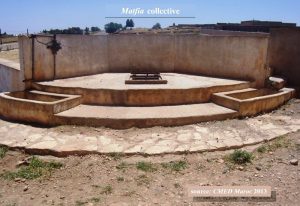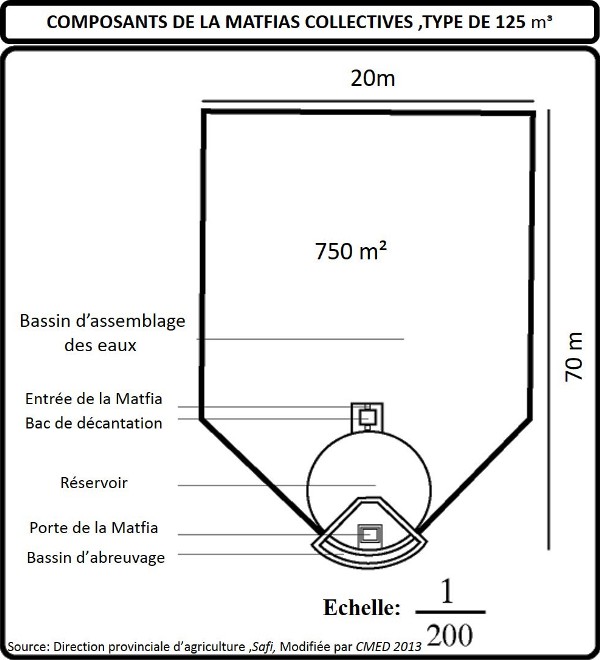محطات المياه
In rural area of Morocco, runoff is harvested for livestock use into natural ponds (dayas) and earth dikes (ghdir) constructed across the rivers, while for human use it is collected in underground cisterns (jbouds).
In this case study we focus on a particular type of cistern called Matfia(s) or Ntafi(s). The Matfia is a very old technique, used in many parts of Morocco, like Doukkala, Little, Middle and High Atlas and the Abda valley.

Hydria Virtual Museum
The traditional Matfias or Ntafis
These are cisterns that are found either underground or above ground, where rainwater is stored to meet the needs of households, livestock and garden irrigation. They are widespread in many parts of Morocco and North Africa. Their construction requires an investment of human effort. They can be constructed either by:
- Local communities in rural areas (modern municipalities or traditional community organisations known as Jamaa)
- Private initiatives or through community action programmes (i.e. by the inhabitants of a village. Small village in rural area is called Douar or in some areas called Dchar or Qçar)
The traditional systems of collective or private Matfias are usually built outside the homes, but they can also be found within the housing complexes. They are used for storing rainwater that flows from roofs during the rainy seasons (fall, winter and spring).
The system works through collecting the storm streams. It is comprised of an underground cistern combined with a collection surface called “Impluvium” (Mssab in Arabic) that has a rectangular or square shape and can reach up to 800m² (for collective Matfias). Usually the basin has a cemented floor and is surrounded by a low wall 50cm – 60cm tall, constructed of stone or cement. The channels that lead the rainwater in to the cistern are called “Segouia or Mejleb”.

Hydria Virtual Museum
Components and characteristics of Matfias
Any Matfia, may it be collective or private, is generally composed of the following components:
- the water collection surface or catchment area that is surrounded by a short protective wall. The surface varies ranges from ~100 – 200m2 for individual Matfias up to 800 m2 for collective Matfias servicing more than a dozen households. This surface has a small inclination so that water flows naturally towards the entrance of the cistern.
- The settling tank: it is a small tank of ~ 1 m3 that is used for the accumulation of sediments (pebble, sand, clay, etc.) carried by rainwater. In this way only the overflowing clean water enters the main cistern tank.
- The water reservoir: This tank usually has the shape of a cylinder. Its storage capacity varies from one region to another and is usually between 100 and 300 mᶟ. The tanks in the Abda region have an estimated storage capacity of 125 m3.
- The opening door: It is usually made of iron ore and has a square or rectangular shape with a size about 0.5 m2.

Hydria Virtual Museum
- Below the door there is a ladder connecting the top to the bottom of the cistern. This is used by humans for maintenance and cleaning purposes.
- The water trough (Jabiya) is a basin built around or next to the Matfia with a main purpose of watering the livestock. Moreover the tough is used for washing and rinsing the laundry, cereal and household appliances.

Hydria Virtual Museum
- In some cases the Matfia is equipped with a hand pump.
Water that runs off the roof during the rainy seasons is sent to a cistern, usually dug in the courtyard of the house. In our days the cistern / tank is made waterproof by using concrete (béton armé) or other waterproof materials. This does not allow leakages, nor evaporation of the stored water. In the past this cistern was made by using clay mixed with straw. The volume of a cistern in a typical traditional Matfia ranges between 60 and 120 m3. In most cases this volume is not enough to cover all domestic needs, but at least for the case of water scarce areas it reduces the necessity of carrying water from elsewhere.
Overall, the Matfias found in Abda and other arid and semi-arid regions of the country is part of the socio-cultural, economic and agricultural Moroccan life. They are adapted to the local environmental conditions and climate, but also to the needs of the rural population living in difficult ecosystems. That said, the know-how (or heritage) related to Matfias is today threatened by the encroachment of new technologies of water management in similar geographical areas in the plains of Abda.
Faced with this situation, the preservation of Matfias system as a rich cultural legacy, and the survival of the different forms of social organisation relating to them (e.g. traditional Jamaa) requires action from the state, local authorities & NGOs, the private sector as well as international organizations (UNESCO, FAO, etc.).



